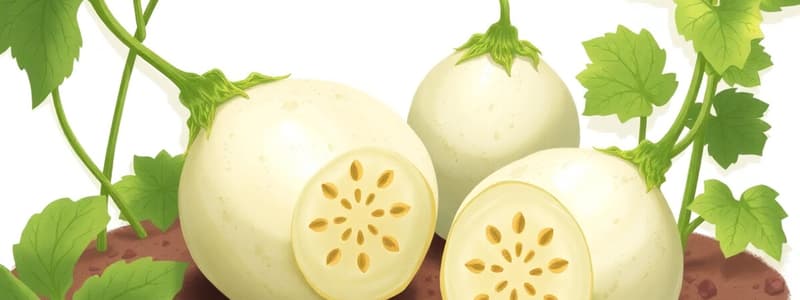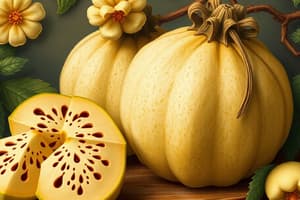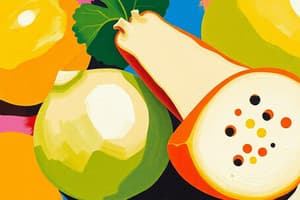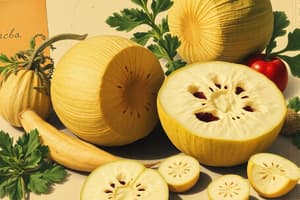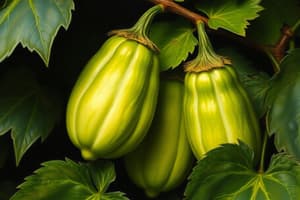Podcast
Questions and Answers
What is the botanical classification of jicama in terms of its growth type?
What is the botanical classification of jicama in terms of its growth type?
- Shrub
- Tree
- Herbaceous (correct)
- Woody
Which characteristic defines jicama as a perennial plant?
Which characteristic defines jicama as a perennial plant?
- It can survive more than two years. (correct)
- It has a short life cycle of less than a year.
- It reproduces through seeds every year.
- It grows in tropical regions only.
Where was jicama first domesticated?
Where was jicama first domesticated?
- South America (correct)
- Africa
- North America
- Southeast Asia
Which two regions are the primary areas where jicama is widely grown and used?
Which two regions are the primary areas where jicama is widely grown and used?
What is the first step in processing the jicama tuberous root for consumption?
What is the first step in processing the jicama tuberous root for consumption?
Which characteristic best describes Jatropha curcas?
Which characteristic best describes Jatropha curcas?
What is the primary economic purpose for cultivating Jatropha curcas?
What is the primary economic purpose for cultivating Jatropha curcas?
After harvesting, what is the next processing step for Jatropha seeds?
After harvesting, what is the next processing step for Jatropha seeds?
Which process directly follows the crushing of Jatropha seeds?
Which process directly follows the crushing of Jatropha seeds?
What is the purpose of filtering the extracted oil from Jatropha?
What is the purpose of filtering the extracted oil from Jatropha?
What flavor characteristic is most commonly associated with sage leaves?
What flavor characteristic is most commonly associated with sage leaves?
In which region is marjoram predominantly preferred in cooking?
In which region is marjoram predominantly preferred in cooking?
What main ingredient is combined with basil for making pesto sauce?
What main ingredient is combined with basil for making pesto sauce?
What is a key characteristic of the Mint Family that affects its use in cooking?
What is a key characteristic of the Mint Family that affects its use in cooking?
Which of the following statements about the economic importance of the Mint Family is true?
Which of the following statements about the economic importance of the Mint Family is true?
What is a common consequence of drying leaves from the Mint Family?
What is a common consequence of drying leaves from the Mint Family?
What best describes rosemary's flavor profile?
What best describes rosemary's flavor profile?
In which industry are the essential oils from the Mint Family predominantly utilized?
In which industry are the essential oils from the Mint Family predominantly utilized?
Which of the following crops is classified as a monocot and is primarily propagated through underground stems?
Which of the following crops is classified as a monocot and is primarily propagated through underground stems?
What characteristic of potatoes contributed to their high susceptibility to disease, particularly during the Irish famine?
What characteristic of potatoes contributed to their high susceptibility to disease, particularly during the Irish famine?
Which factor is primarily responsible for the pungent flavor of Allium species?
Which factor is primarily responsible for the pungent flavor of Allium species?
Which region is identified as the origin of the potato, which became a staple food source in Europe?
Which region is identified as the origin of the potato, which became a staple food source in Europe?
Which of the following statements about taro is accurate?
Which of the following statements about taro is accurate?
What is essential for ensuring the safety of cassava consumption?
What is essential for ensuring the safety of cassava consumption?
Which characteristic distinguishes sweet potatoes from yams in grocery stores?
Which characteristic distinguishes sweet potatoes from yams in grocery stores?
What can be inferred about the carrot and parsnip based on their family classification?
What can be inferred about the carrot and parsnip based on their family classification?
What is primarily responsible for the nutritional content of sweet potatoes?
What is primarily responsible for the nutritional content of sweet potatoes?
Which country is noted as one of the largest producers of sugar cane globally?
Which country is noted as one of the largest producers of sugar cane globally?
What was a significant social consequence of the establishment of sugar plantations in the Caribbean by Europeans?
What was a significant social consequence of the establishment of sugar plantations in the Caribbean by Europeans?
What method is primarily used to propagate sugar cane?
What method is primarily used to propagate sugar cane?
Which process occurs after the sugary juice is extracted from sugar cane?
Which process occurs after the sugary juice is extracted from sugar cane?
What percentage of the global sugar supply is produced from sugar beets?
What percentage of the global sugar supply is produced from sugar beets?
Which of the following best describes the growth habit of sugar cane?
Which of the following best describes the growth habit of sugar cane?
What is significant about the economic importance of sugar cane?
What is significant about the economic importance of sugar cane?
Which statement about the native region of sugar cane is correct?
Which statement about the native region of sugar cane is correct?
What type of environmental conditions does sugar cane primarily require for optimal growth?
What type of environmental conditions does sugar cane primarily require for optimal growth?
What is a distinguishing feature of sugar cane in terms of its physical characteristics?
What is a distinguishing feature of sugar cane in terms of its physical characteristics?
Flashcards
Jicama Family
Jicama Family
Jicama belongs to the Pachyrhizus plant family.
Type of Jicama Plant
Type of Jicama Plant
Jicama is a herbaceous vine, a herb, and perennial plant.
Jicama's Native Area
Jicama's Native Area
Jicama originates from a specific region/location.
Jicama Domestication Region
Jicama Domestication Region
Signup and view all the flashcards
Jicama Harvesting Part
Jicama Harvesting Part
Signup and view all the flashcards
Jatropha Family
Jatropha Family
Signup and view all the flashcards
Jatropha Plant Type
Jatropha Plant Type
Signup and view all the flashcards
Jatropha Economic Use
Jatropha Economic Use
Signup and view all the flashcards
Jatropha Oil Extraction - Step 1
Jatropha Oil Extraction - Step 1
Signup and view all the flashcards
Jatropha Oil Extraction - Step 2
Jatropha Oil Extraction - Step 2
Signup and view all the flashcards
Mint Family spices
Mint Family spices
Signup and view all the flashcards
Rosemary
Rosemary
Signup and view all the flashcards
Essential oils
Essential oils
Signup and view all the flashcards
Eudicots
Eudicots
Signup and view all the flashcards
Mediterranean Region
Mediterranean Region
Signup and view all the flashcards
Thyme's uses
Thyme's uses
Signup and view all the flashcards
Oregano's origin
Oregano's origin
Signup and view all the flashcards
Sage's flavor profile
Sage's flavor profile
Signup and view all the flashcards
Basil's culinary uses
Basil's culinary uses
Signup and view all the flashcards
Peppermint use
Peppermint use
Signup and view all the flashcards
Monocot Onion Family
Monocot Onion Family
Signup and view all the flashcards
Potato's Origin
Potato's Origin
Signup and view all the flashcards
Potato's Classification
Potato's Classification
Signup and view all the flashcards
Potato Blight Famine
Potato Blight Famine
Signup and view all the flashcards
Yam Propagation
Yam Propagation
Signup and view all the flashcards
Taro's classification
Taro's classification
Signup and view all the flashcards
Taro's origin
Taro's origin
Signup and view all the flashcards
Cassava's role
Cassava's role
Signup and view all the flashcards
Cassava's preparation
Cassava's preparation
Signup and view all the flashcards
Sweet Potato Use
Sweet Potato Use
Signup and view all the flashcards
Sugar Cane Species
Sugar Cane Species
Signup and view all the flashcards
Sugar Cane Origins
Sugar Cane Origins
Signup and view all the flashcards
Plant Sugar Source
Plant Sugar Source
Signup and view all the flashcards
Economic Importance
Economic Importance
Signup and view all the flashcards
Perennial Plant
Perennial Plant
Signup and view all the flashcards
Sugar Cane Cultivation
Sugar Cane Cultivation
Signup and view all the flashcards
Sugar Beet Production
Sugar Beet Production
Signup and view all the flashcards
Sugar Cane Harvesting
Sugar Cane Harvesting
Signup and view all the flashcards
Napoleonic Wars Impact
Napoleonic Wars Impact
Signup and view all the flashcards
Sugar Cane's Global Significance
Sugar Cane's Global Significance
Signup and view all the flashcards
Study Notes
Jicama (Pachyrhizus erosus)
- Family: Pea family (Fabaceae)
- Type of Plant: Herbaceous vine
- Life Cycle: Perennial (lives longer than 2 years)
- Native Distribution: Mexico and Central America
History as a Food Plant
- Domestication: First domesticated in Mexico, dating back to 3000 BC. Found in archaeological sites in Peru.
- Widely Grown in: Central America and Southeast Asia
- Introduction to Southeast Asia: Introduced by the Spanish in the 17th century, becoming popular in countries like the Philippines and China.
Utilization
- Part Used: Tuberous root
- Processing:
- Harvesting: Root harvested from the ground
- Peeling: Thin brown skin removed
- Cutting: Cut into sticks, cubes, or slices
- Consumption: Eaten raw in salads, salsas, or as a crunchy snack. Can be cooked in stir-fries, soups, and stews, retaining a crisp texture.
Studying That Suits You
Use AI to generate personalized quizzes and flashcards to suit your learning preferences.
